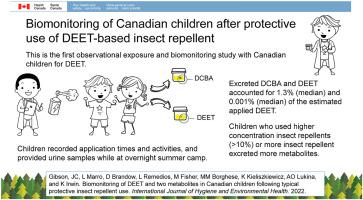International Journal of Hygiene and Environmental Health ( IF 4.5 ) Pub Date : 2022-12-09 , DOI: 10.1016/j.ijheh.2022.114093 Jennifer C Gibson 1 , Leonora Marro 1 , Danielle Brandow 1 , Lauren Remedios 1 , Mandy Fisher 1 , Michael M Borghese 1 , Katarzyna Kieliszkiewicz 2 , Anna O Lukina 1 , Kim Irwin 3

|
N,N-diethyl-m-toluamide (DEET) is an ingredient found in many consumer insect repellents and its use is recommended to Canadians by government agencies, including Health Canada, for protection against insect bites including mosquitos and ticks. The majority of research on DEET exposure and toxicokinetics in humans has focused on adult populations with little information from vulnerable populations, including children. We aimed to fill this knowledge gap by examining real-world exposure data for DEET and its metabolite 3-diethylcarbamoyl benzoic acid (DCBA) in a sample population of Canadian children. We conducted a 24-h observational exposure human biomonitoring study at three overnight summer camps in Ontario, Canada through July and August 2019. Participating children aged 7–13 years provided multiple spot urine samples over a 24-h period and completed a journal to document insect repellent use and factors that could influence absorption of DEET. Children were instructed to use insect repellent as they usually would while attending a summer camp. Exposure was quantified using the information from the participant's journal and the change in the mass of their insect repellent containers over the course of the study. A total of 389 urine samples were collected from 124 children. Among participants using insect repellent, urinary levels of DEET were elevated between 2 and 8 h post-application and decreased thereafter but remained qualitatively higher than concentrations in participants who did not use insect repellent on the study day, even at 18–22 h post-application. DCBA was the predominant metabolite of DEET exposure in urine. DCBA was elevated between 8 and 14 h post-application, and declined thereafter, but not to the level observed among those who did not use insect repellent on the study day. Children who used more insect repellent, or used higher concentration insect repellent (10%–30% DEET) excreted higher levels of DEET and DCBA. Excreted DEET and DCBA accounted for 0.001% (median) and 1.3% (median) of the estimated applied DEET, respectively. Children did not reach an undetectable level of DEET or DCBA in urine, even among those not using insect repellent during the study day, indicating a potentially complex multi-route exposure to insect repellents in a real world scenario. This work provides targeted biomonitoring data for children intentionally using DEET-based insect repellents for normal protective use, and will support the risk re-evaluation of DEET by Health Canada.
中文翻译:

加拿大儿童在使用典型的保护性驱虫剂后对 DEET 和 DCBA 的生物监测
N,N-二乙基-间甲苯酰胺 (DEET) 是许多消费者驱虫剂中的一种成分,包括加拿大卫生部在内的政府机构建议加拿大人使用它来防止蚊子和蜱虫等昆虫叮咬。大多数关于人体避蚊胺暴露和毒代动力学的研究都集中在成年人群上,而来自弱势群体(包括儿童)的信息很少。我们旨在通过检查加拿大儿童样本人群中避蚊胺及其代谢物 3-二乙基氨基甲酰基苯甲酸 (DCBA) 的真实暴露数据来填补这一知识空白。截至 2019 年 7 月和 8 月,我们在加拿大安大略省的三个过夜夏令营中进行了一项 24 小时观察性暴露人体生物监测研究。7-13 岁的参与儿童在 24 小时内提供了多个点尿样,并完成了一份记录驱虫剂使用和可能影响 DEET 吸收的因素的日志。在参加夏令营时,孩子们被告知要像往常一样使用驱虫剂。使用参与者日记中的信息以及研究过程中驱虫剂容器质量的变化来量化暴露程度。共收集了 124 名儿童的 389 份尿液样本。在使用驱虫剂的参与者中,避蚊胺的尿液水平在施用后 2 至 8 小时升高,此后下降,但在质量上仍高于研究当天未使用驱虫剂的参与者的浓度,即使在施用后 18-22 小时也是如此。应用。DCBA 是尿液中 DEET 暴露的主要代谢物。DCBA 在施用后 8 到 14 小时之间升高,此后下降,但未达到在研究当天未使用驱虫剂的人群中观察到的水平。使用更多驱虫剂或使用更高浓度驱虫剂(10%–30% DEET)的儿童排泄出更高水平的 DEET 和 DCBA。排泄的 DEET 和 DCBA 分别占估计应用 DEET 的 0.001%(中位数)和 1.3%(中位数)。儿童尿液中的 DEET 或 DCBA 未达到检测不到的水平,即使在研究期间未使用驱虫剂的儿童中也是如此,这表明在现实世界场景中可能存在复杂的多途径暴露于驱虫剂。











































 京公网安备 11010802027423号
京公网安备 11010802027423号